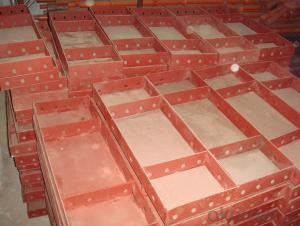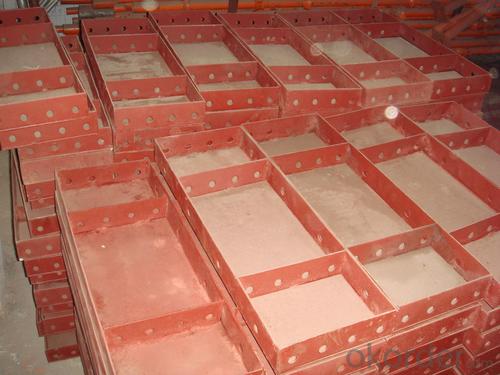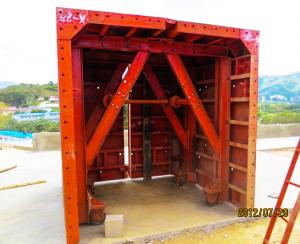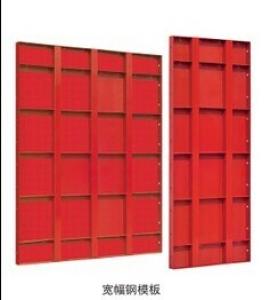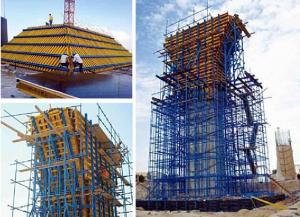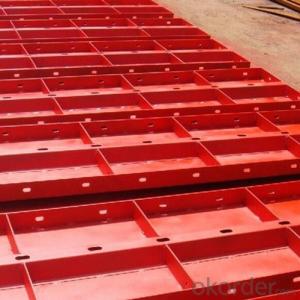Steel form
- Loading Port:
- China Main Port
- Payment Terms:
- TT OR LC
- Min Order Qty:
- -
- Supply Capability:
- -
OKorder Service Pledge
OKorder Financial Service
You Might Also Like
Specifications
Steel Formwork, Available in Various Weights, Dimensions and Area, Suitable for Docks
Steel formwork
Were engaged in development and manufacturing of the special type steel formwork for highways, railways, bridges, tunnels, walls, docks, reservoirs, large-scale stadiums, exhibition centers, and more
Specifications:
Dimension: 300 x 1,500 x 55, 300 x 1,200 x 55, 300 x 900 x 55, 300 x 600 x 55, 250 x 1,500 x 55, 250 x 1,200 x 55, 250 x 900 x 55, 250 x 600 x 55, 100 x 100 x 1,500, 100 x 100 x 1,200, 100 x 100 x 900, and 100 x 100 x 600mm
Area/pc:0.45, 0.36, 0.27, 0.18, 0.375, 0.30, 0.225, 0.15, 0.30, 0.24, 0.18, and 0.12m2
Weight: 17.99, 14.98, 11.86, 8.68, 15.60, 13.80, 10.46, 7.87, 15.40, 12.86, 10.86, and 7.48kg
Other dimensions and shapes are subject to mutual discussions
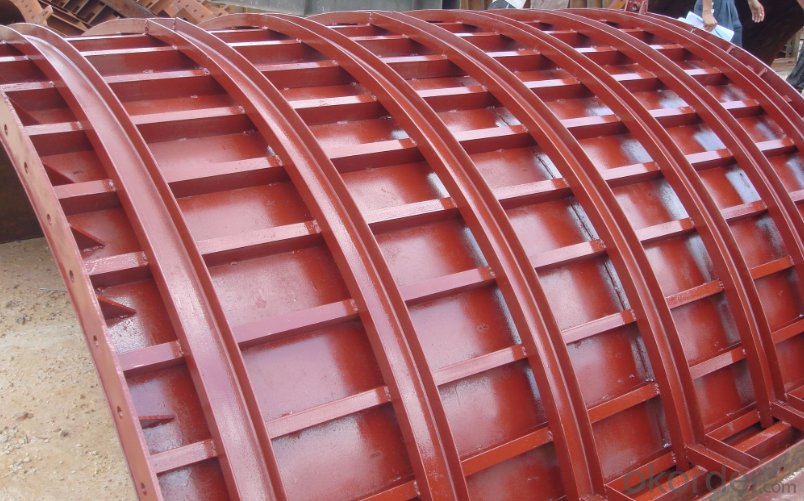
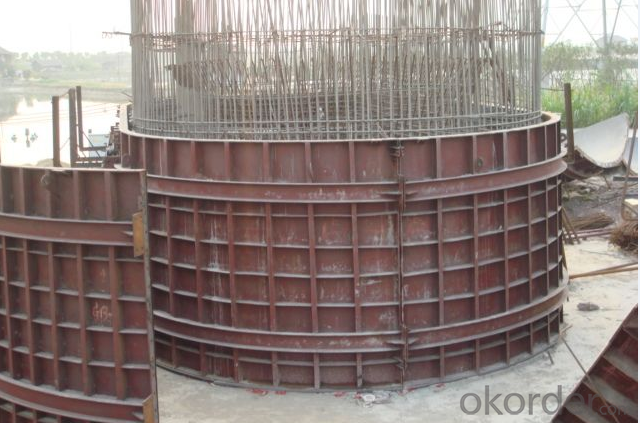
- Q: What are the different types of steel formwork systems available?
- There are several different types of steel formwork systems available, including traditional steel formwork, modular steel formwork, and tunnel formwork. Traditional steel formwork consists of steel panels and supports that are assembled on-site to create the desired formwork structure. Modular steel formwork, on the other hand, is pre-assembled in a factory and can be easily transported and installed. Lastly, tunnel formwork is a specialized type of steel formwork used for constructing tunnels, where the formwork is moved forward as the tunnel progresses.
- Q: What are the typical fire resistance ratings of steel formwork systems?
- The typical fire resistance ratings of steel formwork systems can vary depending on several factors such as the type of steel used, the thickness of the steel, and the overall design and construction of the formwork system. However, in general, steel formwork systems are known for their high fire resistance properties. Steel is a non-combustible material, which means it does not contribute to the spread or intensity of fire. It has a high melting point and does not ignite or release flammable gases when exposed to fire. As a result, steel formwork systems can withstand high temperatures and provide excellent fire resistance. In many cases, steel formwork systems are designed to meet or exceed specific fire resistance ratings specified by building codes and regulations. These ratings are typically expressed in terms of a time period, such as 1 hour, 2 hours, or more, which represents the duration for which the formwork system can maintain its structural integrity and protect against fire. The fire resistance ratings of steel formwork systems can be further enhanced by incorporating additional fire protection measures such as fire-resistant coatings or insulation materials. These measures can provide an extra layer of protection and increase the overall fire resistance of the formwork system. It is important to note that fire resistance ratings can also depend on other factors such as the presence of fire-resistant materials in the surrounding structure and the overall fire safety measures implemented in the building. Therefore, it is crucial to consult with structural engineers, architects, and fire safety experts to determine the specific fire resistance requirements and ratings for steel formwork systems in a particular construction project.
- Q: Can steel formwork be used in areas with high moisture content?
- It is indeed possible to utilize steel formwork in regions with abundant moisture. Thanks to its outstanding durability and resistance to corrosion, steel proves to be an appropriate material for use in environments characterized by high moisture levels. Unlike wood and various other materials, steel formwork does not absorb water or expand, thereby ensuring the preservation of its structural integrity and shape. Furthermore, steel formwork can be effortlessly cleaned and dried, thus minimizing the risk of mold and mildew growth in areas with excessive moisture. Nevertheless, it may be essential to undertake proper maintenance and surface treatment, such as painting or galvanizing, in order to enhance the steel's moisture resistance and prevent rusting as time passes.
- Q: What are the common design considerations for steel formwork in bridge construction?
- When discussing steel formwork in bridge construction, there are several important factors that must be taken into consideration. These factors include: 1. Ensuring Strength and Stability: Engineers must design the steel formwork to withstand the various loads it will encounter during construction, including the weight of wet concrete and any equipment used. The formwork needs to provide sufficient strength and stability to ensure the safety of workers and the integrity of the structure. 2. Emphasizing Durability and Reusability: Designing the steel formwork to be durable and reusable is essential. It should be able to endure multiple uses without significant deterioration, which helps reduce costs and minimize waste. 3. Allowing for Flexibility and Adaptability: The design of the steel formwork should be flexible and adaptable to accommodate different bridge geometries and dimensions. This is particularly important as each bridge may have unique design requirements. 4. Prioritizing Ease of Assembly and Disassembly: The formwork should be designed for easy assembly and disassembly, as this expedites the construction process and reduces labor costs. Quick and efficient assembly and disassembly can also minimize disruptions to traffic flow during construction. 5. Focusing on Safety: Safety is a critical consideration in any construction project, including steel formwork. The design should incorporate safety features to protect workers during assembly, disassembly, and concrete pouring. These features may include guardrails, access platforms, and fall protection systems. 6. Striving for Cost-effectiveness: The design of the steel formwork should aim to be cost-effective. This involves considering factors such as material selection, fabrication methods, and ease of transport and installation. The goal is to optimize the overall cost of the formwork while maintaining its functionality and performance. In conclusion, the design considerations for steel formwork in bridge construction revolve around ensuring strength, stability, durability, reusability, flexibility, adaptability, ease of assembly and disassembly, safety, and cost-effectiveness. By carefully addressing these considerations, engineers can ensure the successful and efficient construction of bridges using steel formwork.
- Q: How does steel formwork contribute to the overall fire safety of the building?
- Steel formwork contributes to the overall fire safety of the building in several ways. Firstly, steel is a non-combustible material, meaning it does not burn or contribute to the spread of fire. This helps to minimize the risk of fire spread and containment breaches within the structure. Additionally, steel formwork provides structural stability and strength, which is crucial during a fire event as it helps to maintain the integrity of the building and prevents structural collapse. Steel also has a high melting point, allowing it to withstand high temperatures for longer periods before it weakens, providing additional time for evacuation and firefighting efforts. Overall, the use of steel formwork enhances the fire resistance of the building, ensuring the safety of occupants and minimizing potential damage.
- Q: How does steel formwork contribute to sustainable construction?
- Steel formwork contributes to sustainable construction in several ways. Firstly, steel is a durable and long-lasting material, ensuring that the formwork can be reused multiple times, reducing the need for new materials and minimizing waste in the construction process. Additionally, steel formwork allows for precise and accurate construction, reducing the amount of material and resources required for repairs or adjustments. Furthermore, steel is recyclable, and at the end of its life cycle, the formwork can be recycled and used in the production of new steel products, reducing the environmental impact. Overall, the use of steel formwork promotes sustainability by minimizing waste, conserving resources, and reducing environmental pollution.
- Q: How does steel formwork contribute to the overall strength and stability of a structure?
- The construction industry heavily relies on steel formwork to enhance the strength and stability of structures. This crucial component plays a vital role in maintaining the integrity and durability of buildings by providing a dependable support system during the process of pouring concrete. To begin with, steel formwork possesses exceptional strength and rigidity, enabling it to withstand the immense weight and pressure exerted by wet concrete. Its sturdy construction ensures that it does not deform or collapse under these heavy loads, thereby preventing any potential damage or compromise to the stability of the structure. Furthermore, steel formwork provides an accurate and precise framework for pouring concrete. The dimensional stability of steel ensures that the formwork retains its shape and dimensions throughout the construction process. This accuracy is crucial in achieving a structurally sound and level structure, as any misalignment or irregularity in the formwork can lead to uneven distribution of concrete and weaken the overall strength of the building. Moreover, steel formwork exhibits excellent resistance to moisture and corrosion. This resistance guarantees that the formwork remains intact and structurally sound, even in environments with high humidity or exposure to water. By preventing rust and deterioration, steel formwork maintains its strength and stability over time, thus contributing to the long-term durability of the structure. Another notable advantage of steel formwork is its reusability. Unlike traditional wooden formwork, steel formwork can be reused multiple times without compromising its structural integrity. This reusability not only reduces construction costs but also minimizes waste and environmental impact. The ability to reuse steel formwork ensures that subsequent concrete structures maintain consistent strength and stability, without any compromise in quality. In conclusion, steel formwork is an indispensable element in the construction industry, significantly enhancing the strength and stability of structures. Its exceptional strength, dimensional accuracy, resistance to moisture and corrosion, and reusability make it an ideal choice for ensuring the integrity and durability of concrete structures. By providing a robust and reliable support system, steel formwork plays a pivotal role in the construction of safe and long-lasting buildings.
- Q: How does steel formwork perform in seismic-prone areas?
- Steel formwork performs well in seismic-prone areas due to its inherent strength and durability. Unlike other types of formwork, such as timber or plywood, steel formwork offers superior resistance to seismic forces. It provides a rigid and stable structure that can withstand the lateral forces generated during an earthquake. One of the key advantages of steel formwork in seismic-prone areas is its ability to maintain structural integrity and stability. The high tensile strength of steel enables it to resist the strong shaking and ground motions associated with seismic activity. This means that steel formwork is less likely to deform, crack, or collapse during an earthquake, ensuring the safety of the structure and the workers involved in construction. Moreover, steel formwork has excellent load-bearing capacity, which is crucial in seismic-prone areas. The formwork system provides robust support to the concrete during casting and curing, ensuring that the structure remains intact even under dynamic loading conditions. This ability to withstand heavy loads is particularly important in earthquake-resistant design, as it helps prevent structural failure and the consequent loss of life and property. In addition to its strength, steel formwork offers other benefits in seismic-prone areas. It is highly reusable, durable, and resistant to moisture, which makes it ideal for construction projects in regions with high seismic activity. The reusability of steel formwork reduces construction waste and allows for cost savings in the long run. Furthermore, steel formwork is versatile and adaptable, making it suitable for various structural applications in seismic-prone areas. It can be easily customized to fit different shapes and sizes, allowing for efficient construction of complex structures. This flexibility is crucial in earthquake-resistant design, where the formwork needs to conform to specific architectural and structural requirements. Overall, steel formwork is an excellent choice for construction in seismic-prone areas. Its strength, durability, load-bearing capacity, reusability, and adaptability make it a reliable and efficient solution to withstand the forces exerted by earthquakes. By utilizing steel formwork, construction projects can enhance the safety and resilience of structures in regions prone to seismic activity.
- Q: How does steel formwork contribute to faster construction?
- There are several ways in which steel formwork speeds up construction. Firstly, steel formwork is exceptionally durable and can endure multiple uses. This means it can be reused on various construction projects, reducing the need to constantly manufacture new formwork. This not only saves time but also cuts costs associated with buying new materials for each project. Moreover, steel formwork is quick and simple to assemble and disassemble. The modular nature of steel formwork allows for efficient installation and removal, enabling construction teams to complete projects at a faster pace. This is particularly advantageous for projects with tight schedules or where speed is crucial. Furthermore, steel formwork provides a smooth and consistent surface finish, eliminating the need for additional plastering or finishing work. This saves time and effort during the construction process, as there is no need to wait for plaster or other finishing materials to dry before moving on to the next stage. Additionally, steel formwork offers greater design flexibility. Steel can be easily fabricated into various shapes and sizes, allowing for the construction of complex structures. This versatility eliminates the need for expensive and time-consuming custom formwork solutions, as steel formwork can be adapted to meet the specific requirements of each project. Lastly, steel formwork is renowned for its excellent strength and stability. It can withstand heavy loads and adverse weather conditions, ensuring the safety and stability of the construction site. This reduces the risk of delays due to structural issues or the need for additional reinforcements, allowing the construction process to progress smoothly and efficiently. Overall, the use of steel formwork in construction projects speeds up construction by providing durability, easy assembly and disassembly, a smooth surface finish, design flexibility, and enhanced strength and stability. These factors combined help to streamline the construction process and reduce the overall project timeline.
- Q: How does steel formwork compare to plastic formwork in terms of cost and durability?
- Steel formwork generally tends to be more expensive than plastic formwork due to the higher cost of steel as a material. However, steel formwork offers better durability and longevity compared to plastic formwork. Steel can withstand heavy loads and repetitive use, making it more suitable for large-scale construction projects. While plastic formwork may be more cost-effective for smaller and temporary projects, steel formwork is a more cost-efficient and durable option for long-term use.
Send your message to us
Steel form
- Loading Port:
- China Main Port
- Payment Terms:
- TT OR LC
- Min Order Qty:
- -
- Supply Capability:
- -
OKorder Service Pledge
OKorder Financial Service
Similar products
Hot products
Hot Searches
Related keywords
